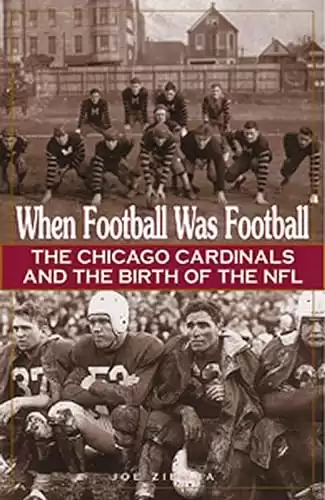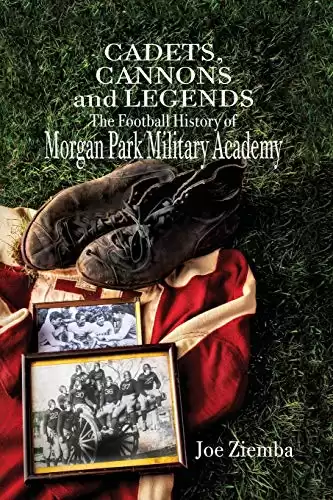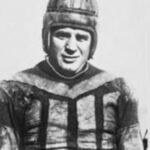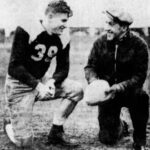Every year about this time, from 1934 through 1976, an enormous football extravaganza took place each summer that captured the interest of football fans across the country. It was the annual College All-Star Football game which pitted the defending NFL champions against a team of recently graduated collegiate players who were selected by a nationwide vote of the fans. Before the creation of the Super Bowl, this game was indeed the BIG ONE on the football calendar, drawing over 100,000 fans and a huge television audience.
On this episode of “When Football Was Football,” we’ll charge into the very beginnings of the All-Star game including when it started and how it was developed. Of course, it became wildly successful, and we’ll examine the reasons behind that as well. When it began in 1934, the concept of the game was a fan’s delight, and here’s why…
Ever since the National Football League was formed in 1920 as the American Professional Football Association, there was verbal sniping going back and forth between the professional interests and their collegiate counterparts. These discussions, mostly from college coaches, centered on both the value and the talent level, in the professional ranks.
Critics were quick to point out that the pros lacked the old college “spirit” and there was no way for the pros to achieve the fitness achieved by college players due to the daily practice sessions by the latter. Pro football, it was feared, was run by gangsters, crooks, and other unruly personnel who were only out to make a quick buck at the expense of the poor college graduates who were coerced into playing for pitiful wages on one of those undignified pro teams.
College Players Should Not Pursue Football
Simply put, there was a general feeling that college football players should drop football forever when their team’s schedule was completed during their senior year. As college graduates, they should have no difficulty in obtaining a respected employment position rather than pursue rolling around in the mud, the blood, and the beer of professional football.
Of course, there was no on-field competition between the two parties. After all, one could never expect a college team to lower itself and play a pro football team. Things were so bad that players who did dip their toes into the pro ranks often played under assumed names and concealed their identities, long after they left college.
Even referees were not immune. Conferences such as the Pacific Coast Conference and what we now know as the Big Ten prohibited their referees from officiating any professional game. Some schools, including the University of Chicago, vowed to revoke the letters of any former players who participated in a pro football game. Strange, strange stuff!
The mutual distrust displayed by both sides seemed to forever eliminate the chance that the two would ever cooperate. For example, in November of 1923, legendary University of Chicago coach Amos Alonzo Stagg blasted the concept of pro football in a blistering release that found itself on the front pages of newspapers across the country.
Stagg said: “To patronize Sunday professional football games is to cooperate with forces which are destructive of the finest elements of interscholastic and intercollegiate football.”
A Most Unusual Football Game!
Then in 1925, Red Grange signed with the Chicago Bears before his class graduated at the University of Illinois. Although Illinois had completed its 1925 schedule before Grange fled to the pros the day after his final game, this decision prompted another barrage of negative comments about the NFL.
So, in July of 1934, it was somewhat of a surprise when the Chicago Tribune and its iconic sports editor, Arch Ward, announced the staging of the first All-Star game to be played on August 31, 1934. Ward was an intriguing individual who likely thought of himself more as a promoter than an editor. After all, he developed the first major league baseball All-Star game and helped create the Golden Gloves boxing tournament.
Pulling off this first game on such a short time period would prove to be an audacious challenge for Arch Ward. Not only would he need to work with George Halas and the NFL to ensure their participation, but he would need to organize a voting procedure, reserve the vast Soldier Field for the game itself, and also find a way to attract the fans.
Part of this magic act was to arrange for the fans to vote for the All-Stars, but the participation of the hometown Bears was also a smart move. And hopefully, the members of the College All-Star team would accept their invitations on such short notice once the voting was completed. Ward’s official announcement of the game in the Tribune was concise and to the point in revealing this massive undertaking:
“This is an announcement of the most unusual football game ever scheduled. It will bring together the Chicago Bears, champions of the National Professional league, and the strongest team of last year’s college seniors that can be recruited…
It is up to you, the football fans of Chicago and America. Never before have you had a chance to pick the starting players for a college team. We hope you make the most of it.”
Bears Smack Notre Dame All-Stars
There was some precedence for the initial All-Star football game. In 1933, the Chicago Bears played an exhibition game in Chicago’s Soldier Field against a group of Notre Dame All-Stars. The concept proved appealing to Arch Ward, so the first College All-Star game was planned, which would pit the outstanding collegians from the previous season against the defending professional champions.
Perhaps the most interesting aspect of the game was the enormous amount of discussion that the game initiated. Specifically, would the pros or the collegians prevail? More importantly, with this game, that question would finally be answered! And there was no shortage of opinions.
While the host Chicago Tribune barraged its readers with insightful daily information on both teams in the weeks before the game, the fans participated as well by voting for both the All-Star players and their coaches in nationwide tabulations. The program for the 1934 game proclaimed that over 165,000 people had cast votes for the players. Tackle Ed Krause of Notre Dame was the leading vote-getter with over 65,000 votes.
Arch Ward had put together a national network of newspapers to help with this effort and the top two vote-getters at each position were added to the roster and about ten others were included to ensure that enough reserves were available. Shortly thereafter, it was revealed that the voting for the All-Stars’ head coach, which turned out to be Noble Kizer of Purdue, witnessed a return of over 617,000 votes. Of course, it did not hurt that the opponent of the All-Stars would be none other than the local Chicago Bears, champions of the NFL in 1933.
Like other local newspapers, the Chicago Daily News was largely silent, which is quite understandable in view of its competitor’s huge commitment to the game, it did take the opportunity to comment on the one major rule change that could not be agreed upon. At the collegiate level, that ball could not be passed unless the thrower was at least five yards behind the line of scrimmage. The pros had dumped that rule a year earlier, allowing a pass to be thrown from anywhere behind the line.
It really opened up the game but the All-Star coaches would not agree to apply that rule to this contest. As the Daily News commented: “The Pros have been forced to remodel their attack, but still should carry too many guns for the All-Stars.”
Halas Expects Tough Battle
Others were not so sure about that prognosis. George Halas, the owner of the Bears, reminded fans that the All-Star coaches would have their pick of the finest players in the entire country, while the in pros, Halas said: “We have seven or eight other clubs trying to grab off the best of the college players for professional football.” Hall of Famer Link Lyman of the Bears added: “These All-Stars are going to be tough, plenty tough, make no mistake about that. We’re in for a battle.”
No matter your opinion, the excitement was present as game day approached. Even referee James Masker noted: “We officials knew that no championship game ever had aroused a greater desire to win than had this All-American and Bears battle.”
On the night of the game, Ward treated the attendees to a special light show while introducing the college players and then the two squads settled down for what would be a hard-hitting, but rather boring, scoreless tie.
The Bears and the All-Stars managed just nine first downs between them and only four passes were completed. However, the overall game of football proved to be the ultimate winner with nearly eighty thousand in attendance and an increased national awareness of the game. For over forty years, this annual event drew huge crowds and traditionally kicked off the ensuing football season.
While this game certainly eased the tensions between the power brokers of college and professional football (and was a major contributor to local charities), it forced most pro teams to open training camp without several key rookies who were members of the All-Star team. They would be forced to wait until the players completed their All-Star commitments which, in the very early days, involved more than one All-Star extravaganza.
Yet the first All-Star game did not really decide anything on the field, except that good football was played at both levels. Later in 1934, another prospectus emerged when there was talk of the Bears playing the University of Minnesota, the collegiate front-runners. While this game was never played, the battle of words continued as the idea was tossed around.
Minnesota fullback Stan Kostka said: “We’d take them all right. We are better organized and play as a team, they don’t.” Noble Kizer, the inaugural All-Star coach stated: “Pro players are inclined to loaf.” To which former Chicago Cardinals’ coach Fred Gillies remarked: “A college player doesn’t realize how little he knows until he tries to play pro ball. The great experience and knowledge of the Bears would enable them to win.” Star Bears halfback Beattie Feathers added: “We’d wear them down and beat them.”
Pros Begin to Dominate
There was finally some retribution for the pros in the 1935 All-Star game when the Chicago Bears edged the collegians by the unusual score of 5-0. The outcome really didn’t stifle the pros vs. college debate initially, but over the years, the pros began to dominate the All-Stars.
When the game was finally discontinued after a rain-shortened 1976 contest, the NFL champs had won 31 of the games while the collegians grabbed nine wins, and two games ended in ties. Crowds of over 100,000 watched the Bears play in 1947 and the Cardinals in 1948.
Those glory years of All-Star football are now long gone, but the memories of those wonderful, and exciting battles remain. Thank you for joining us tonight on this episode of “When Football Was Football” and I hope you can be with us next time when we explore the discovery of some “lost” games played over the years by both the Bears and the Cardinals.
Author and Host - Joe Ziemba
Joe Ziemba is the host of this show, and he is an author of early football history in the city of Chicago. Here, you can learn more about Joe and When Football Was Football, including all of the episodes of the podcast.
Please Note – As an Amazon Associate I earn from qualifying purchases
Resources
More From When Football Was Football
Paddy Driscoll’s Almost Perfect Season
Back at the beginning of the National Football League in...
Read More120,000 Fans Witness High School Football Game in 1937!!!
Let’s set the stage… It was a warm November afternoon...
Read MoreIn The Beginning: An Interview With Joseph T. Sternaman
And, you may ask, who is Joseph T. Sternaman? Sternaman...
Read More1948: The Last Hurrah of the Chicago Cardinals
Cardinals’ fans are familiar with the long, sad story concerning...
Read More




